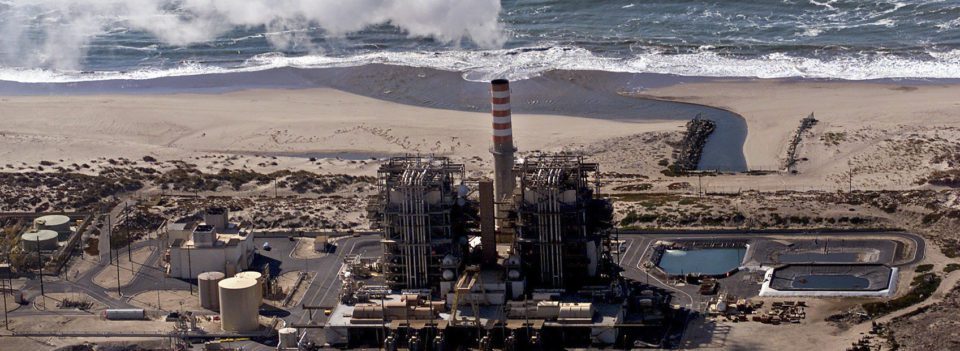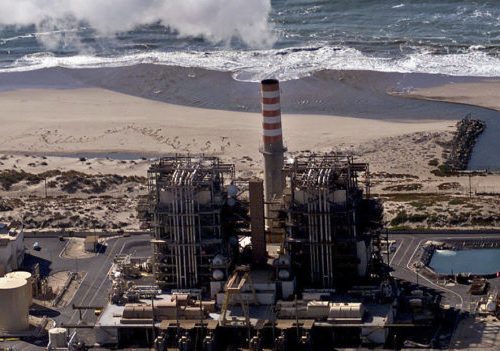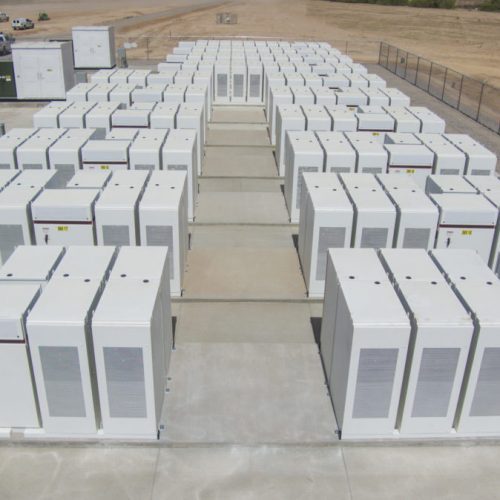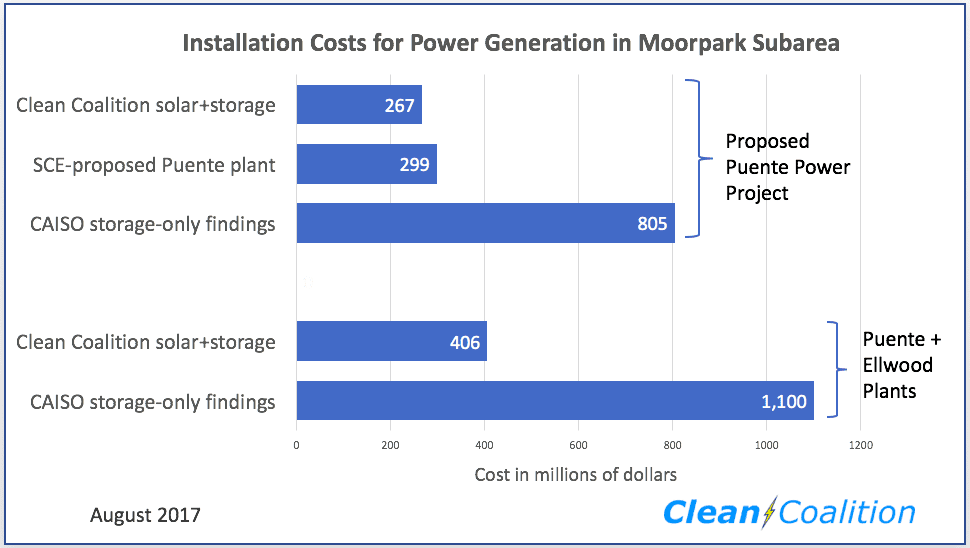The Best Ideas from COP30, the UN Climate Summit in Brazil – 18 December 2025
The Clean Coalition was a partner organization for this webinar, which took place on 18 December 2025 at 10am.
Read More
The Clean Coalition shows that solar+storage is cheaper than these proposed gas peaker projects

In 2017, the Clean Coalition released a study showing that use of solar+storage would be cheaper than building the proposed Puente Power Project natural gas plant and could cost-effectively replace the Ellwood Peaker Plant. The projects are both part of the Moorpark Subarea in California, which includes the cities of Oxnard, Santa Barbara, and Goleta. They were approved to meet local electricity capacity requirements that are currently served by about 2,000 megawatts (MW) from the Mandalay and Ormond Beach power plants in this grid-constrained area of the Southern California Edison (SCE) service territory. Because both the Mandalay and Ormond facilities are out of date and will not conform to new state regulations, they’re expected to be retired at the end of 2020.

The Clean Coalition leveraged its unique policy, technical, and economic expertise to model realistic alternatives to the Puente and Ellwood plants. The models show that a solar+storage solution is achievable at $267 million to install, compared to $299 million for the Puente proposal. Solar+storage could replace both Puente and Ellwood for approximately $406 million.
The Clean Coalition’s study is in stark contrast to a study conducted by the California Independent System Operator (CAISO), which manages the state’s electric grid. CAISO’s study evaluated only storage, while ignoring far more cost-effective solar+storage, and concluded that replacing the Puente plant with incremental distributed energy resources and storage would cost $805 million, with a cost of up to $1.1 billion to replace both the Puente and the Ellwood plants.


The CAISO study also left out the costs of operations, maintenance, and fuel. These are expected to run about $19 million per year for Puente based on current costs, making it about twice as expensive as a solar+storage design. Accounting for these costs would raise the total cost of Puente to over $870 million over thirty years. A comparable calculation for a solar+storage facility would run about $462 million. Including the health, mortality, and social costs of carbon from the natural gas plant would increase the cost of Puente and Ellwood dramatically.
In October 2017, the California Public Utilities Commission (CPUC) unanimously rejected the proposed refurbishment of the Ellwood Peaker Plant, while the California Energy Commission indicated it will reject the project and has suspended the application pending an effort to procure renewable DER as an alternative to Puente. The Clean Coalition’s technical and economic models were a key element in demonstrating that the polluting natural gas plant would be highly uneconomical for ratepayers.
However, because of concerns about ensuring adequate energy supply, in November 2019 the CPUC voted to allow several coastal gas plants slated for closure or rebuilding to remain operational through 2022.
To prepare for gas plant closures, SCE has been implementing a plan to procure a wide range of renewables projects throughout Ventura and Santa Barbara Counties to meet the area’s needs without the Puente and Ellwood peaker plants in combination with an expensive and vulnerable transmission line. Unfortunately, SCE is proposing to use the old utility procurement method of a Request For Proposals (RFP). However, RFPs are notoriously too slow and wasteful, resulting in unnecessarily high costs for ratepayers. Furthermore, SCE has unwisely limited its RFP to the northern part of the larger area, on a theory that transmission will be cheaper than DER — but without a full RFP, that conclusion is unsupported and appears to be entirely false. Given SCE’s poor record of successfully procuring DER with its RFOs, there is a risk that the RFO will fail and SCE will attempt to force through the unneeded gas plant anyway.
The Clean Coalition is working to stage DER projects and advocating for a Feed-In Tariff (FIT) program with Market Responsive Pricing instead, as a quicker, cheaper, and more reliable way to install clean local energy in the Moorpark Subarea. Under this program, SCE would procure all the needed capacity through a modified FIT involving a series of offer rounds. Each round would offer developers standard contract terms, streamlined interconnection processes, and a market-based price set by an initial market auction and the market response to prior rounds. Unlike RFOs, FITs with Market Responsive Pricing have a solid success record in delivering cost-effective clean local energy, in California and around the world.
** October 2021 update: The Goleta Planning Commission has approved the development plan and conditional use permit for a new 60-megawatt lithium ion energy storage facility. This facility could be instrumental in retiring the Ellwood plant.
Solar+storage model for Puente and Ellwood capacity requirements
Solar+storage model for Ellwood capacity requirements
Addressing the revised Moorpark Subarea solar+storage procurement plan in Southern California (September 7, 2018)
Procuring DER with a CLEAN FIT in Southern California (January 17, 2018)
Economic analysis demonstrating DER benefits in Southern California (January 16, 2018)
Environmental Justice FIT proposal for the CPUC (November 1, 2017)
Feed-in Tariff letter to the CPUC (October 31, 2017)
How Feed-In Tariffs Can Unleash Clean Local Energy and Obviate Polluting Gas Plants in California | The Energy Collective (January 18, 2018)
Gas Under Threat? California Regulators Target PG&E Natural Gas Plants With Energy | Greentech Media (December 20, 2017)
Solar+storage may now be cheaper than gas | Solar Power World (October 30, 2017)
California rejects gas peaker plant, seeks clean energy alternatives | PV Magazine (October 4, 2017)
Ellwood gas peaker plant is unanimously rejected (October 2, 2017)
Solar+storage is more cost-effective than proposed gas plants in Southern California (September 7, 2017)
The latest in clean local energy
Learn about our innovative projects and initiatives on our blog, and see what others are reporting about our important work.
The Clean Coalition was a partner organization for this webinar, which took place on 18 December 2025 at 10am.
Read MoreThis podcast episode of Energy Central's "Power Perspectives" welcomes Craig Lewis, Founder and Executive Director of the Clean Coalition, to explore how local solar and storage can flatten the duck curve, cut costs, and build a more resilient grid.
Read articleThe Clean Coalition presented during this in-person gathering, held on Friday, 5 December 2025 from 3:30–5:00 pm PST at CEC’s Environmental Hub, 1219 State St Suite A, Santa Barbara, CA 93101.
Read More